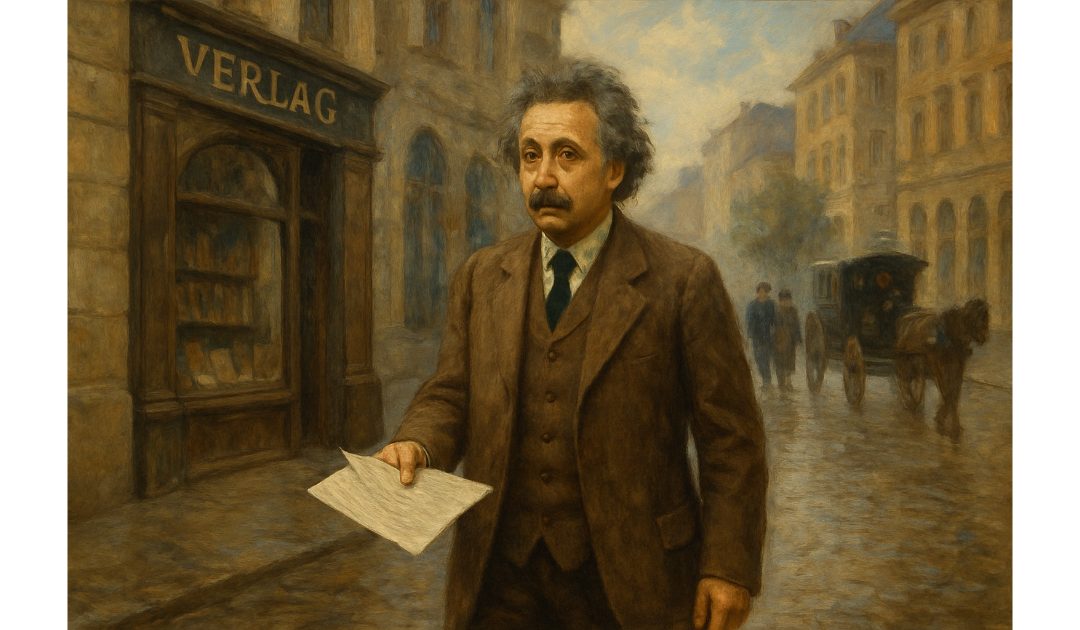On the 26th of September, 1905, Albert Einstein published the third of his Annus Mirabilis Papers. The third paper introduced his theory of special relativity.
Albert Einstein’s theory of special relativity revolutionised our understanding of space, time, and motion. This groundbreaking theory emerged from Einstein’s quest to reconcile the laws of mechanics with the principles of electromagnetism, specifically addressing inconsistencies related to the behaviour of light.
Historical Context and Motivation
Before Einstein, physics was heavily influenced by Newtonian mechanics, which described motion and forces with remarkable precision for everyday phenomena. However, as scientists delved deeper into the nature of light and electromagnetism, discrepancies arose. The core issue was the speed of light. According to James Clerk Maxwell’s equations, light’s speed in a vacuum is constant. Yet, classical mechanics suggested that speeds should be additive; for example, a car moving at 60 mph relative to the ground, with a ball thrown forward inside at 10 mph, would imply the ball’s speed relative to the ground is 70 mph. Applying this logic to light led to contradictions.
The Michelson-Morley experiment in 1887 attempted to detect the Earth’s motion through a supposed “aether,” a medium thought necessary for light propagation. Surprisingly, the experiment yielded null results, indicating no detectable aether and suggesting light’s speed remained constant, regardless of the Earth’s motion. This puzzling outcome set the stage for Einstein’s revolutionary ideas.
Foundations of Special Relativity
Einstein’s theory is built on two fundamental postulates:
- The Principle of Relativity: The laws of physics are the same in all inertial frames of reference (frames moving at constant speeds relative to each other).
- The Constancy of the Speed of Light: The speed of light in a vacuum is constant (approximately 299,792 kilometres per second) and does not depend on the motion of the light source or the observer.
These deceptively simple principles have profound implications. They challenge the traditional notions of absolute time and space, suggesting instead that time and space are intertwined and relative to the observer’s frame of reference.
Key Concepts and Consequences
- Time Dilation:
- Time dilation implies that time passes at different rates for observers in different inertial frames. A classic thought experiment involves a moving spaceship with a light clock (a beam of light bouncing between two mirrors). To an observer on the ship, the light travels vertically. However, to an outside observer, the ship’s motion causes the light to follow a diagonal path, longer than the vertical one. Since light’s speed is constant, it must take more time to cover this distance. Hence, time runs slower for the moving observer compared to the stationary one. This phenomenon has been experimentally verified, such as with atomic clocks flown on high-speed aircraft showing slight time differences compared to those on the ground.
- Length Contraction:
- Objects in motion appear contracted along the direction of motion to a stationary observer. This phenomenon, known as length contraction, means that a moving ruler would measure shorter than when it’s at rest. This effect becomes significant only at speeds approaching the speed of light.
- Relativity of Simultaneity:
- Events that appear simultaneous to one observer may not be simultaneous to another moving observer. This challenges the classical idea of a universal present moment, highlighting that simultaneity is relative.
- Mass-Energy Equivalence:
- Perhaps the most famous outcome of special relativity is the equation E=mc², which reveals that mass and energy are interchangeable. This principle underlies nuclear reactions, where tiny amounts of mass convert into enormous energy, as in the sun’s fusion processes or nuclear power.
Mathematical Framework
Special relativity employs Lorentz transformations to relate coordinates and times between different inertial frames. These equations replace the classical Galilean transformations and ensure consistency with the constant speed of light. They mathematically describe how space and time coordinates change for observers in relative motion.
Experimental Confirmations
Special relativity has withstood rigorous experimental scrutiny. Beyond time dilation observed in fast-moving particles and precision clocks, length contraction and relativistic mass changes are confirmed through particle accelerators. Cosmic rays, for instance, produce muons high in the atmosphere. Without time dilation, these muons would decay before reaching the Earth’s surface, yet they do, aligning with relativistic predictions.
Impact and Legacy
Einstein’s special relativity fundamentally reshaped physics, paving the way for his later development of general relativity, which extends the concepts to non-inertial (accelerating) frames and incorporates gravity. The theory’s principles are essential in modern technologies: GPS satellites account for time dilation effects to provide precise location data.
Philosophically, special relativity challenges intuitive perceptions of reality. The idea that time and space are not absolute but relative to the observer’s motion alters our fundamental understanding of the universe.
Conclusion
Albert Einstein’s special relativity remains one of the cornerstones of modern physics. Its elegant principles, confirmed by extensive experimental evidence, continue to influence scientific thought, technology, and our comprehension of the cosmos. By transforming notions of time, space, and energy, Einstein’s work opened new horizons in both theoretical and applied physics.

